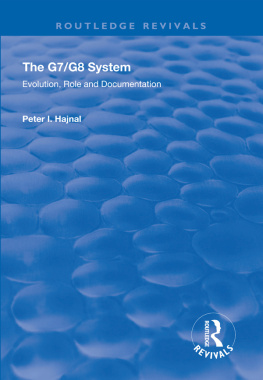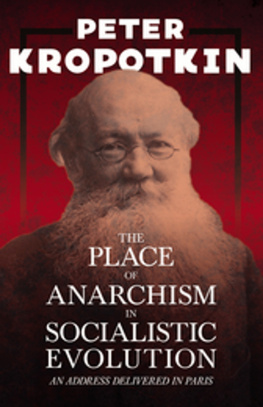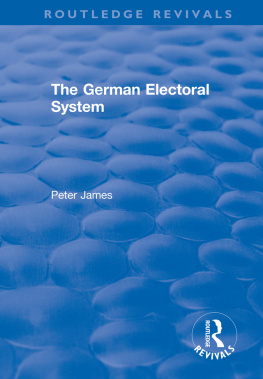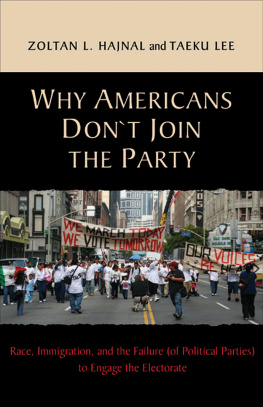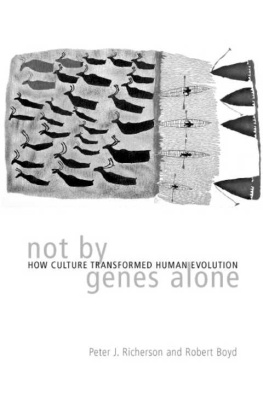THE G7/G8 SYSTEM
The G8 and Global
Governance Series
The G8 and Global Governance Series explores the issues, the institutions and the strategies of participants in the G8 network of global governance, as they address the challenges of shaping global order in the new millennium. Intensifying globalization is moving many once domestic issues into the international arena, requiring constant international co-operation, and demanding new collective leadership to direct the galaxy of multilateral institutions created in 1945. In response, the Group of Eight, composed of the worlds major market democracies, including Russia and the European Union, is emerging as the effective source of global governance in the new era. This series focuses on the new issues at the centre of global governance, from finance, investment, and trade, through transnational threats to human security, to traditional political and security challenges. It examines the often invisible network of G8 and G7 institutions as they operate within and outside established international organizations to generate desired outcomes. It analyzes how individual G7 members and other international actors, including multinational firms and those from civil society, devise and implement strategies to secure their preferred global order.
Also in the series
The G8s Role in the New Millennium
Edited by
Michael R. Hodges, John J. Kirton and Joseph P. Daniels
ISBN 1 84014 774 1
The G7/G8 System
Evolution, role and documentation
PETER I. HAJNAL
University of Toronto
With a contribution by Sian Meikle, University of Toronto
First published 1999 by Ashgate Publishing
Reissued 2018 by Routledge
2 Park Square, Milton Park, Abingdon, Oxon, 0X14 4RN
711 Third Avenue, New York, NY 10017, USA
Routledge is an imprint of the Taylor & Francis Group, an informa business
Copyright Peter I. Hajnal 1999
All rights reserved. No part of this book may be reprinted or reproduced or utilised in any form or by any electronic, mechanical, or other means, now known or hereafter invented, including photocopying and recording, or in any information storage or retrieval system, without permission in writing from the publishers.
Notice:
Product or corporate names may be trademarks or registered trademarks, and are used only for identification and explanation without intent to infringe.
Publishers Note
The publisher has gone to great lengths to ensure the quality of this reprint but points out that some imperfections in the original copies may be apparent.
Disclaimer
The publisher has made every effort to trace copyright holders and welcomes correspondence from those they have been unable to contact.
A Library of Congress record exists under LC control number: 99072597
ISBN 13: 978-1-138-34922-3 (hbk)
ISBN 13: 978-1-138-34924-7 (pbk)
ISBN 13: 978-0-429-43640-6 (ebk)
Contents
11 G7/G8 Information: Internet Resources
Sian Meikle
by Sir Nicholas Bayne
The G7-now G8-is an institution. It brings together the governments of the United States, Japan, Germany, France, Italy, the United Kingdom, and Canada (the original seven powers) with the European Union (Commission and Presidency) and most recently Russia. It embodies both an annual summit and a proliferation of other meetings, ministerial or official, regular or occasional, avowed or unpublicised. But it is not an organisation. It does not have a charter, a headquarters or a secretariat, let alone a cafeteria or a pension plan, both identified by the late Dr Michael Hodges as vital signs of an organisation.
Most important, the G7/G8 does not have a public relations department, an information service or a web site. Other institutions-the International Monetary Fund, the World Trade Organization, the OECD-are prodigal in the information they disseminate. The G7/G8 is secretive and unforthcoming, apart from agreed communiques and other documents which issue from its meetings. True, each time a G8 member hosts a summit or similar meeting, it produces extensive briefing material and, these days, creates a web site. Other G8 members may do the same, even if not hosts. But all this material has national origins and-inevitably-a national bias. There is no collective information effort. Nothing is done for those curious about the G7/G8 itself, whether journalists, academic researchers, non-G8 governments or the general public. In some ways the G7/G8 has even gone backwards. Originally the G7 heads of government all took part in the concluding press conference. Now they brief separately, leaving only the host to present the final declaration.
How, then, can anyone find out about the G7/G8? Fortunately, since 1988, the University of Toronto G7, now G8, Research Group has been filling the gap left by the G7/G8 itself. Over the last ten years it has built up, with the implicit encouragement of the G7/G8 governments, a comprehensive archive in both written and electronic form and a body of analytical work accessible to scholars and the general reader alike.
Peter Hajnal is the librarian and bibliographer of the Research Group. He has an encyclopaedic command of this material. From it he has created, in this volume, the first guide-book or manual to the G7/G8. He explains how it started, who takes part and how it works. He traces its development from a single annual summit, prepared by quasi-independent sherpas, to the present intricate network of ministerial conferences, specialised meetings, working groups and task forces; from a limited list of economic themes to an agenda open to every possible international topic; from the two-page statement produced at the first summit at Rambouillet in 1975 (President Giscard resisted even this) to the hundreds of pages issued by G7/G8 meetings in 1998, even though the actual summit documents were half the length of previous years. Peter Hajnal has the skill and experience needed to guide us through this labyrinthine documentation. This extends beyond the papers issued by the G7/G8 itself to wider analytical writings about it; and his book concludes with a thorough bibliography.
Sian Meikle, the University of Toronto Librarys web development co-ordinator and the author of of this book, has been instrumental in designing and developing the G8 Information Centre web site in cooperation with the G8 Research Group. Her survey of internet resources of G7/G8 information, along with her thorough analysis of the patterns of use of the Information Centre, form a most valuable component of this guide.
Peter Hajnal possesses what Thomas Carlyle called transcendent capacity of taking trouble. He has taken immense trouble to make this guide reliable and definitive. It is comprehensive in coverage, precise in accuracy, meticulous in attention to detail, judicious in interpretation. Anyone who is curious about the G7/G8, puzzled by its statements or baffled by its workings, will find this book an indispensable source of instruction.
This study is based on the assumption that the G7/G8 is one of the central international institutions of the 1990s and, potentially, of the twenty-first century. Notwithstanding serious criticism of its institutional growth, proliferating agenda and lack of representativeness, the G7/G8 has achieved more than some critics would have us believe, and has been able to secure a significant degree of compliance from its members on a number of issues. It has also served as an effective means of socialising the leaders and ministers of member states, enabling them to get well-acquainted with one another and to understand one anothers domestic political and economic constraints, and providing them with a means of policy coordination. Questions remain, however, about the effectiveness of the G7/G8 in changing the behaviour of non-member states and multilateral institutions, and in improving broader global conditions.


